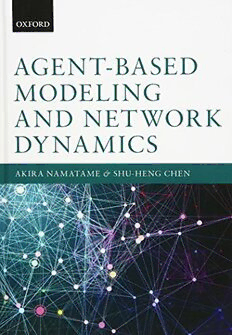Table Of ContentAGENT-BASED MODELING AND NETWORK DYNAMICS
Agent-Based Modeling
and Network Dynamics
Akira Namatame
NationalDefenseAcademy,Japan
Shu-Heng Chen
NationalChengchiUniversity,Taiwan
3
3
GreatClarendonStreet,Oxford,OX26DP,
UnitedKingdom
OxfordUniversityPressisadepartmentoftheUniversityofOxford.
ItfurtherstheUniversity’sobjectiveofexcellenceinresearch,scholarship,
andeducationbypublishingworldwide.Oxfordisaregisteredtrademarkof
OxfordUniversityPressintheUKandincertainothercountries
©AkiraNamatameandShu-HengChen2016
Themoralrightsoftheauthorshavebeenasserted
FirstEditionpublishedin2016
Impression:1
Allrightsreserved.Nopartofthispublicationmaybereproduced,storedin
aretrievalsystem,ortransmitted,inanyformorbyanymeans,withoutthe
priorpermissioninwritingofOxfordUniversityPress,orasexpresslypermitted
bylaw,bylicenceorundertermsagreedwiththeappropriatereprographics
rightsorganization.Enquiriesconcerningreproductionoutsidethescopeofthe
aboveshouldbesenttotheRightsDepartment,OxfordUniversityPress,atthe
addressabove
Youmustnotcirculatethisworkinanyotherform
andyoumustimposethissameconditiononanyacquirer
PublishedintheUnitedStatesofAmericabyOxfordUniversityPress
198MadisonAvenue,NewYork,NY10016,UnitedStatesofAmerica
BritishLibraryCataloguinginPublicationData
Dataavailable
LibraryofCongressControlNumber:2015944353
ISBN978–0–19–870828–5
Printedandboundby
CPIGroup(UK)Ltd,Croydon,CR04YY
LinkstothirdpartywebsitesareprovidedbyOxfordingoodfaithand
forinformationonly.Oxforddisclaimsanyresponsibilityforthematerials
containedinanythirdpartywebsitereferencedinthiswork.
Abstract
Social environments influence much of what people do. To be more precise, individual
behaviorisofteninfluencedbysocialrelationswithothers.Socialinfluencereferstothe
behavioral change of individuals affected by other people. Individual behavior is often
governed by formal and informal social networks. Networks are created by individu-
als forming and maintaining relationships that, in turn, influence individual behavior.
Hence,consideringindividualbehaviorwithinthecontextofanexplicitnetworkstruc-
turegivesusamodelthathelpstoexplainhowpeopleconnectwiththeirpeers,andwhy
theybecomeincreasinglysimilartotheirpeersovertime.
Agent-based modeling has grown out of many disparate scientific fields, including
computerscience,physics,biology,economics,andothersocialsciences.Inconjunction
with the increasing public interest in complex networks, there has been a coalescence
of scientific fields interested in agent-based approaches and network science. Each of
thesefieldsbringsimportantideastothediscussion,andacomprehensiveunderstanding
seemstorequireasynthesisofperspectivesfromallofthem.Theseareideasthathave
traditionallybeendispersedacrossmultipledisciplines.Thus,understandinghighlycon-
nectedindividualbehaviorrequiresasetofideasforreasoningaboutnetworkstructures,
strategicbehavior,andfeedbackeffectsacrosslargepopulations.
This text attempts to bridge such multidisciplinary approaches in the ultimate hope
that it might lead to a better understanding of complex social and economic problems.
Byconstructingagent-basedmodels,wedevelopmethodsandtoolsusefulforexploring
thedeepermechanismsunderlyingsocioeconomicdynamics.Webeginbyextrapolating
theoriesofstructureandbehavior,twobodiesoftheorythatwillserveasthefoundation
foragent-basednetworkmodels.Withthissetofideasinmind,weintroducesomeofthe
maintopicstobeconsideredinthebook,andthemeansbywhichthesetopicsarticulate
themechanismsofsocioeconomicdynamics.
This book also serves as an introduction for a general reader to socioeconomic sys-
tems. Its breadth and readability make it especially useful as a starting point for those
whowishtodigdeeperintothesocioeconomicsystemsfromanyacademicbackground
and level. It is richly peppered with facts and simulation results aimed at situating the
models discussed within actual socioeconomic systems. Hardware developments will
soonmakeitpossibletoconstructlarge-scalemodels,withagentsnumberinginthemil-
lions and hundreds of millions. It will be argued that the main impediment to creating
empirically relevant agents on this scale is our current lack of understanding regard-
ingtherealisticbehaviorofagents.Thisepistemicbottleneckobfuscateseffortstowrite
the rules dictating agent behavior, which is the primary challenge faced by researchers
studyingsuchmodels.Networktheoryisthestudyofnetworkstructures,whereasagent-
basedmodeltheorystudiesmodelsofindividualbehaviorinsettingswheretheoutcome
vi Abstract
depends on the behavior of others. The agent approach to networks is at the forefront
ofsuchmodels.
Theauthorsaredeeplyindebtedtoseveralpeople.Thecontributorswereourfriends
andclosecolleagues,alongwithcolleaguesknowntousonlybyname,andtheauthorsof
thebooksandpaperstowhichwereferinthetext.Wethankthosecolleagueswhopro-
videdstimulatingacademicdiscussionanddebateprovokedbythevariousreadingsand
ideas, including Professors Bikas K. Chakrabarti, Yuji Aruka, Dirk Helbing, Thomas
Lux, and Frank Schweitzer. We also thank our wonderful students at the National De-
fense Academy and National Chengchi University, who provided a quiet retreat from
thepressuresofteachingandadministrationduringthelatereditingstages.
Finally, we want to thank all of you who take the time to read this book. We will
be grateful if you gain as much from reading it and thinking about it as we have from
writingit.
Contents
1 Introduction 1
1.1 Agent-BasedModeling:ABriefHistoricalReview 1
1.2 AgentNetworkDynamics 6
1.3 OutlineoftheBook 11
2 NetworkAwarenessinAgent-basedModels 15
2.1 NetworkAwareness 15
2.2 First-GenerationModels:Lattices 16
2.3 Second-GenerationModels:Graphs 38
2.4 AdditionalNotes 63
3 CollectiveDynamicsofAdaptiveAgents 68
3.1 Collectives 68
3.2 BinaryChoiceswithExternalities 71
3.3 AdaptiveChoiceswithReinforcement 78
3.4 NetworkEffectsonAdaptiveChoices 86
4 Agent-BasedModelsofSocialNetworks 91
4.1 Introduction 91
4.2 GameTheoryofNetworkFormation 92
4.3 NetworkGameExperiments 97
4.4 Agent-BasedModeling 104
4.5 TheSkyrms-PemantleModel 105
4.6 TheZimmermann-EguiluzModel 110
4.7 TheZschacheModel 114
4.8 TheBravo-Squazzoni-BoeroModel 119
4.9 Network-basedTrustGames 124
4.10 TowardaGeneralModelofNetworkDynamics 132
4.11 AdditionalNotes 133
5 Agent-BasedDiffusionDynamics 135
5.1 SocialDiffusion 135
5.2 DiffusionModels 137
5.3 MaximizingandMinimizingDiffusionThresholds 146
5.4 ComparisonofDiffusioninNetworks 150
5.5 KeyAgentsinDiffusion 155
viii Contents
6 Agent-BasedCascadeDynamics 162
6.1 SocialContagionandCascadePhenomena 162
6.2 ThresholdModel 166
6.3 CascadeDynamicsinNetworks 172
6.4 OptimizingCascadesinNetworks 181
6.5 CascadeDynamicswithStochasticRule 191
7 Agent-BasedInfluenceDynamics 196
7.1 MutualInfluenceandConsensus 196
7.2 OpinionDynamicsandInfluenceNetwork 199
7.3 ConsensusFormationinNetworks 207
7.4 OptimalNetworksforFastandSlowConsensus 212
7.5 NetworkInterventionwithStubbornAgents 222
8 EconomicandSocialNetworksinReality 230
8.1 Buyer–SellerNetworks 230
8.2 LaborMarketNetwork 234
8.3 WorldTradeNetwork 246
8.4 Summary 252
9 Agent-BasedModelingofNetworkingRisks 253
9.1 NetworkingRisks 253
9.2 SystemicRisks 257
9.3 CascadingFailuresandDefenseStrategies 266
9.4 GainfromRiskSharing 274
10 Agent-BasedModelingofEconomicCrises 286
10.1 Agent-BasedEconomics 286
10.2 ModelDescriptions 289
10.3 SimulationandResults 295
10.4 EvolvingCreditNetworks 305
References 309
Index 323
1
Introduction
1.1 Agent-Based Modeling: A Brief Historical Review
1.1.1 From Equations to Networks
Thebookisabouttheintegrationofagent-basedmodelingandnetworkscience.Agent-
based modeling in social sciences has a long history, while in the early days it was
recognizedbydifferenttermsindifferentdisciplines,forexample,individual-basedmod-
elinginecology(GrimmandRailsback,2005),actor-basedmodelinginsociology(Macy
and Willer, 2002), and interaction-based modeling in social economics (Durlauf and
Young,2004).Inmanydisciplines,beforetheadventofagent-basedmodeling,thedom-
inant approach in modeling social phenomena was equation-based modeling, frequently
characterizedbydifferentialequationsorsystemsofdifferentialequations.
The famous examples are the Lokta-Volterra equation in ecology, the Kermack-
McKendric equation, more popularly known as the SIR (standing for susceptible-
infected-recovered) model in epidemics, and the Bass equation in marketing (Bass,
1969). Those equations describe a dynamic or evolutionary process in a space. The
Lokta-Volterraequationdescribestheevolutionofthepopulationofdifferentspeciesin
anecologicalsystem,suchasintheAmazonRiver,intheSub-SaharanDesert,orinthe
Chernobylnucleardisasterarea.Ontheotherhand,theKermack-McKendricequation
describes the diffusion of the epidemics or pandemics from one single individual to a
large part of society. The Bass equation is the application of the Kermack-McKendric
equation to the diffusion of new products or technology. While these processes can be
meaningfullypicturedinaspatialcontext,thespatialconcernisoftenassumedawayor
abstracted away by the much simpler equation-based modeling. Therefore, it leaves a
generalquestionforsocialscientists:canaspace-freethinkingbegoodenough?Apos-
sibly negative answer to this question is the reason that we see the burgeoning and the
developmentoftheagent-basedmodelingmethodologyinsocialsciences.
What distinguishes agent-based modeling from the conventional equation-based
modeling lies in the spatial factor or the geographical specificity. However, the signif-
icance of the spatial concern is not limited to just spatial mobility or transportation
(Liedtke,2006).Thespatialspecificityturnsouttobeanotherattributeofagents,which
notonlyintroducesaheterogeneityofagentsinanaturalway,butalsohelpsdefineand
Agent-BasedModelingandNetworkDynamics.FirstEdition.AkiraNamatameandShu-HengChen.
©AkiraNamatameandShu-HengChen2016.Publishedin2016byOxfordUniversityPress.

